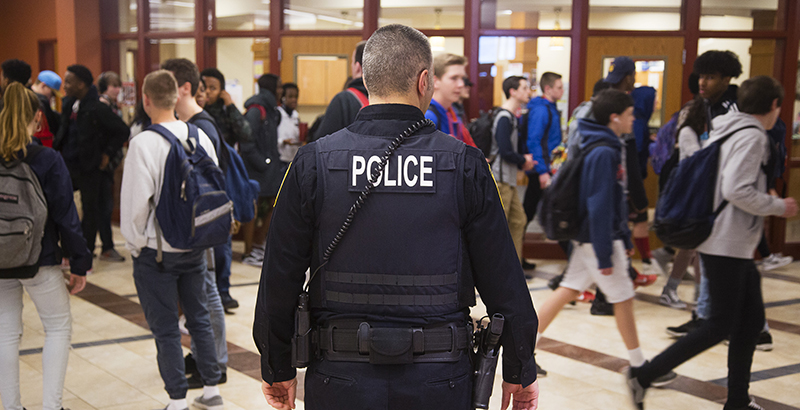Cami Anderson: ‘Police-Free Schools’ Vs. ‘Chaos’ Is a False Choice. Here’s What Districts Must Do to Implement Real Discipline Reform

Updated Aug. 13
This summer brought a long overdue national spotlight to the role racism plays in all aspects of American society, and education has not been spared — nor should it be. Around the country, schools are scaling back and even abolishing long-established systems of policing. Major districts like Minneapolis and Portland, Oregon, moved swiftly to dissociate their schools from city police departments, and the Los Angeles Unified Board of Education approved a 35 percent cut to its school police force.
The police-free schools movement is real and growing — and it’s high time. The criminalization of school discipline and the overpolicing of students, disproportionately Black, is an urgent problem. Nationally, Black students are between 2.5 and 4 times as likely to be suspended or expelled as their white peers. Half of school-based arrests are of Black students, even though they make up 16 percent of the student population. Black students report that they feel less safe, less connected to school and less connected to a caring adult than their white peers. These disparities are life-altering, as even one suspension dramatically increases a student’s chances of involvement with the juvenile justice system. And this isn’t just an urban problem — these dynamics play out for Black students in elite private schools and affluent suburban districts.
Though more education leaders than ever before are talking about school discipline, their discussions rarely move past naming the problem. Too much of the public discourse focuses on a false choice between keeping biased and punitive discipline policies as is or watching schools descend into “chaos,” rather than finding solutions.
The Discipline Revolution Project, an organization I helped found, is working alongside many other organizations to help expose the unjust and alarming impact of current practices. But we can’t stop there. The discipline reform movement must help schools and systems replace police-like tactics with radically better school cultures and student engagement that prevent incidents from occurring to begin with, and implement policies and practices to respond skillfully when they do. If we stay where we are, advocating for slogan-like solutions, we’ll fail in reversing racist patterns and could even create the conditions for a backlash that could make things worse for our most marginalized students.
We can accelerate the work in places like Louisiana, where administrators and teachers are working to address the role adult biases can play in everything from whom we call on to whom we punish to the way we teach history. When kids know their teachers believe in them, expect a lot of them and notice the little things that make them tick, they are motivated to achieve. When students engage in meaningful, challenging work, see themselves in their texts and connect with adults who see and support them — including in times of conflict — learning happens. When students feel a sense of belonging and empowerment, they don’t need to communicate through negative behaviors.
We can deepen and scale the work of notable charter networks, like Valor Collegiate, where educators coach students to build social and emotional skills and create community. Scores of skillful charter school leaders are preparing students to actively partner in running their schools, to study the historical basis for existing inequities and lead the way toward a more just future. Content from organizations like Facing History and Ourselves explicitly teaches kids to be upstanders in their schools and broader communities. Norms formed and upheld by students are so much more successful than those imposed by adults in a punitive, top-down manner.
Even with these preventative measures, we know conflicts and incidents will happen — sometimes serious ones. So some school systems are trying new and innovative approaches toward their responses.
In some schools in New York City, peer mediators step in when students cannot resolve their own conflicts. In Oakland, student-led councils consider and weigh in on decisions about suspensions, on the rare occasions when they come up. Community can be repaired through restorative circles if something happens in the school or neighborhood. Students have opportunities to lead, question and manage their own community.
Let’s be clear: Replacing school police means avoiding overly simple solutions and doing the deep work of radically and urgently rethinking people, practices and policy.
People. Teachers should be selected as carefully for their cultural competence and ability to build relationships as they are for knowing how to construct a lesson. Schools need more high-quality and expertly coached guidance counselors, mental health professionals and social workers, and we need to prioritize roles like peer mediators, so students can lead. Recruiting and retaining educators of color must be a priority.
Police should not be embedded in schools — even with careful training, their loyalties are divided and they are likely to bring elements of toxic cultures that make schools feel less safe, especially to Black students. Some schools may need adults who are dedicated to student and staff security (one system we’ve worked with has a school across the street from a homeless shelter whose residents try to enter regularly; other schools are in neighborhoods with high levels of gun violence). We need to attract trusted members of the community who can connect with young people and neighbors to prevent incidents — and to skillfully handle ones that arise without combative tactics.
Practices. All adults in schools should be committed to growing their skills in building trusting relationships with students, understanding how power, race and biases play out in their interactions and knowing how to de-escalate conflict.
Curricula and libraries need to be carefully examined to make sure they aren’t whitewashing history and stereotyping marginalized students. Students need to be empowered to create their own norms and community. We must dedicate time in schools for lessons, readings, case studies and guided practice to help students develop healthy habits related to managing themselves, their time, their relationships and their response to stress. When kids misstep or experience conflict, school personnel should have the instinct to find out why — and to provide them with opportunities to learn and grow, as opposed to exclude and punish. Educators must understand that psychological and emotional safety are as important as physical safety.
There must be clear guidelines to cover the extremely rare instances when administrators call the police, as in mandatory reporting of violence or abuse, or when there is an active shooter. If they must, handpicked officers trained in youth development should respond, including licensed social workers, where possible.
While discipline reform opponents tried to push guns for teachers and further militarization of school safety in the wake of tragic school shootings, a recent government report found no evidence that restorative approaches make schools less safe. But there’s plenty of evidence that more militaristic and police-like tactics have unintended consequences that hurt kids of color.
Policy. Even the best people with the right mindsets and training can fail in the face of unnecessarily punitive policies. For instance, in some states, it is legal for school-based staff to physically restrain students or even paddle them. Such laws and guidelines need to change. We need to have zero tolerance for any inappropriate use of force or verbal abuse by any school personnel; it happens all too often, and it isn’t just school security who are the offenders.
Another example: The majority of states require schools to report infractions and dictate mandatory sentencing for missteps — in some cases, more punitive than in criminal law. When a student is involved in an incident at school, often one adult is judge, jury and the person empowered to decide the consequence, which is often high-stakes. Students and families have very little recourse in finding out the specifics of what happened, let alone in questioning the result. Often, state education codes and district policies and procedures require students to literally plead “guilty” or “not guilty” as early as elementary school to even minor infractions, like throwing an eraser. This criminalization of behavior in schools has to change, now.
The focus on reducing suspensions must broaden out to include both in- and out-of-school suspensions, school-based arrests, physical restraint, referrals for special education on behavioral or emotional grounds and school transfers. And we need to listen to what students say in polls and surveys about their sense of belonging, or lack thereof, in the schools. We can’t just “reduce suspensions” — we have to get to the root cause of issues, fix them and track progress in a far more sophisticated way.
Even right now, when we should be doing everything possible to support students and families to engage in meaningful online learning and to overcome myriad challenges in doing so, we see the instinct to punish and police. Many were shocked when a 15-year-old was jailed for failing to get online and do her homework remotely, thus violating her probation, during the pandemic. Kids are locked out of Zoom calls for being late. We’ve heard of school systems threatening to “suspend kids” from online instruction for failing to appear on camera with uniforms on or their hair done a certain way. These misguided policies are artifacts of a badly broken school discipline system that needs to be dismantled as vigorously as we tear down antiquated police practices. Instead of doubling down on troubling approaches and applying them in even more costly ways, we should use this moment to take a hard look in the mirror and make long-overdue changes.
This work is urgent and cannot be reduced to simple one-liners. Dismantle school police departments? Yes. And let’s get to the real, deep change that’s needed.
Cami Anderson is CEO of The Discipline Revolution Project, former superintendent of alternative high schools and programs in New York City and former superintendent of Newark Public Schools.
Get stories like these delivered straight to your inbox. Sign up for The 74 Newsletter

;)
